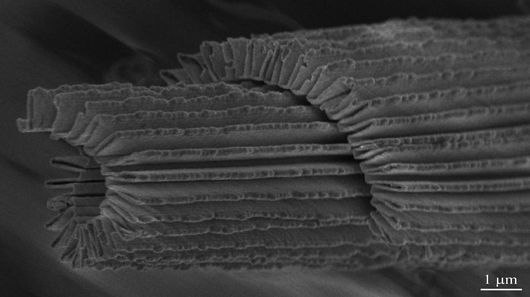
A new conductive, transparent, and stretchable nanomaterial that folds up like an accordion could one day be applied to the development of flexible electronics and wearable sensors, as well as stretchable displays. The researchers at North Carolina State University who created this "nano-accordion" structure caution that it is early days yet, but they hope to find ways to improve its conductivity and eventually scale it up for commercial or industrial use.
A new conductive, transparent, and stretchable nanomaterial that folds up like an accordion could one day be applied to the development of flexible electronics and wearable sensors, as well as stretchable displays. The researchers at North Carolina State University who created this "nano-accordion" structure caution that it is early days yet, but they hope to find ways to improve its conductivity and eventually scale it up for commercial or industrial use.
The researchers took inspiration for their technique from the geometry of the humble spring, which as a part of its function allows otherwise brittle materials to effectively stretch. They created a transparent structure composed of a series of symmetrical zinc-oxide ridges on an elastic polydimethylsiloxane (a kind of silicone) material.
The ridges of zinc oxide allow the structure to expand and contract like the bellows of an accordion, while the thickness of these ridges can be set anywhere in the range of 30 to 70 nanometers – with different optical, mechanical, and electrical properties exhibited along this range.
When the structure stretches, the two sides of each ridge bend apart like a person doing a split (note, though, that unlike people the structure can only stretch in one direction). This means that the structure's stretchability can be refined by altering the height of ridges in the manufacturing stage.
The first time the nano-accordion is stretched, the structure losing some electrical conductivity. But subsequent stretching causes no further changes. You can see a video of how this works in practice below.
The researchers conclude in their study that nano-accordion structures such as these could "potentially lead to novel electronics and sensors that are simultaneously transparent, stretchable, and wearable."
"We’re now working on ways to improve the conductivity of the nano-accordion structures," adds study corresponding author Chih-Hao Chang. "And at some point we want to find a way to scale up the process."

 Previous page
Previous page Back to top
Back to top







